Content Hubs: How to Create an Effective Content Hub in 4 Steps
By Intern |18 Mar 2015
What goes into making an effective content hub that sends loyal customers flocking to your website in their droves?
As part of Fresh Egg’s content team, I’ve been involved in the creation of content hubs for some of our clients over the past couple of years. Here, I take you through the four-step process of how Fresh Egg works with clients to create content hubs.
Not sure what a content hub is exactly, or why your website might need them? Read the first blog post in this series – Content Hubs: What Are They, How Do They Work and Why Does Your Website Need Them? or listen to our podcast:
Now we’ve got the ‘what’ and ‘why’ sorted, how do you actually go about creating a content hub? Here’s how we do it at Fresh Egg:

Step 1: planning and scoping
Before putting pen to paper (or maybe, fingers to keyboard), you need to have a solid grasp of what content you’re going to create, how you’re going to create it and – most importantly – why you’re creating it; what is the objective?
What topic areas should you cover?
First things first, what are you going to create your content about? How do you decide what topic to focus on? There are quite a few things to consider, but answer the questions below and you’ll be well on your way to making the right decision.
- Look at the overall business/digital marketing goals or objectives that you’re currently working towards – what topics will ultimately help you achieve that aim? Effectively, what content is relevant enough to have a long-term impact on your bottom line? (Remembering the slow-burn nature of the effects of this approach).
American Express’ US Open Forum for small businesses publishes a wealth of content designed to help small businesses succeed. Not all of it is directly finance related, but all of it directly appeals to the target audience – small businesses that will need a credit card. The hub reportedly provides Amex’s largest source of inbound leads for their small business card division.

- What marketing campaigns – online and offline – have you got coming up in the future? Can a content hub be created to help support the objectives of those campaigns? For example, say you’re a vehicle-hire business and you’re planning on pushing van rentals in six months’ time. How can your onsite content related to vans be improved? You could create content related to the most common reasons for hiring a van – moving house, for example – and provide a series of resources and checklists to help people moving home.
Fresh Egg created the Discover Cornwall hub, which currently focuses on food and drink in the county, for Sykes Cottages as part of a campaign to drive brand awareness of the holiday lettings company in that area. Food and drink in particular was chosen because analysis of the search landscape showed a high demand for information related to this topic, plus it’s an area that provides huge scope for the creation of engaging and visual content.
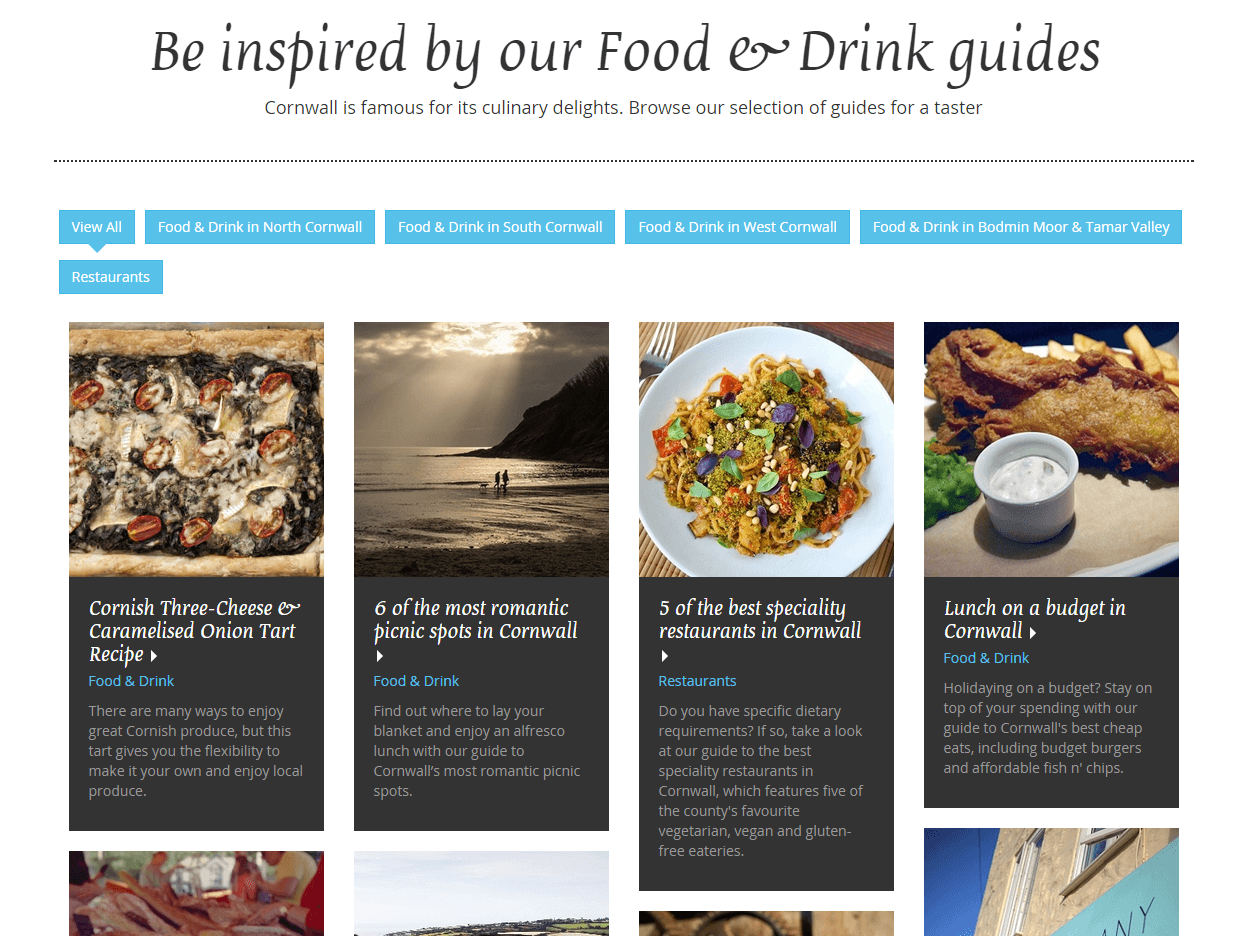
- Customer questions and feedback. What common topics do your customer services team regularly have to deal with? Can you run any customer surveys or analyse your internal site search data (e.g. using Google Analytics) to find out what information people are looking for?
Customer queries can provide a rich source of ideas for content because they provide an indicator that the information they want isn’t on your site. By providing it for them, it could increase customer satisfaction and potentially make them a repeat customer, because they can see you have listened to their queries.
Nationwide Vehicle Contracts’ Useful Guides for Motorists hub, created by Fresh Egg, features a list of FAQs related to vehicle leasing. The common questions included are those regularly asked of the leasing broker’s customer service team, plus those found frequently online. Users can also submit their own questions to be added to the FAQ page.
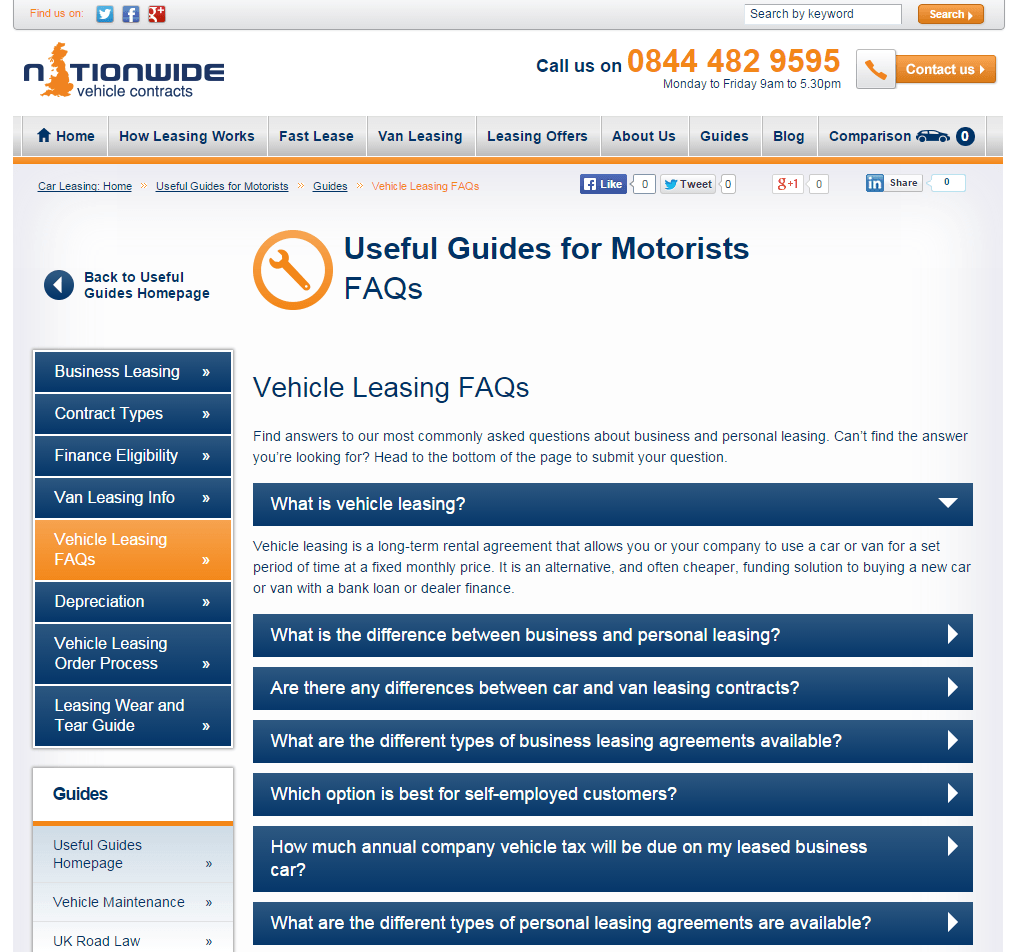
- Post-purchase support. What information can you provide users about how to use or maintain the product or service you’re offering? How-to videos are perfect here. Samsung has recently taken the how-to video one step further, by offering a series of ‘Helpouts’ via Google+ Hangouts to help their customers get to grips with their new technology.
- Competitor activity. What is your opposition doing, and how can your website do it better? What content formats are working well for your competitors? You can use a tool like BuzzSumo to easily find out what competitor activity attracts the most attention (e.g. backlinks and social shares). Look at what is already available to your customer base, and think about how your brand can produce something better in a different format, or at least something from a different angle.
- Search volume and search intent. We’re not talking about chasing rankings here, but if people are looking for the content you’re thinking about creating at all. Use tools such as Google’s Keyword Planner and Google Trends to get an idea of popular topics and trends. If you’re going to create a content hub that is truly useful, you need to understand the motivation behind the search (i.e. the problem the searcher is trying to solve), not just how many people are searching. Use a tool like Fresh Egg’s very own Searchintent.co.uk to help you understand the connections between different topic areas and to begin to understand that motivation. Enter a keyword related to the area you’re interested in and the tool will then provide you with a series of related topics that may help steer the content you create in your hub – the answers may not be as obvious as you think. This combined approach will help you prioritise what goes in the hub.
- Social monitoring. What are people asking about in relation to your brand, product, services and industry across the various social media networks? How can your content meet those needs?
- Future gazing. What is an important consideration for the future of your industry and your customers? Are there any particularly topical conversations that are regularly covered in national news that your brand can show its expertise in? For example, say you’re a car insurance company – how will driverless cars impact your industry?
- Analytics data and existing content. What content do you already have onsite that’s keeping people engaged? How can this be repurposed or expanded upon? Perhaps you have a blog post that’s driving particularly high engagement on a regular basis. Reworking this into a more evergreen format – a downloadable whitepaper, for example – can provide your customers with value-added content in exchange for an email address.
- Are there any connected lifestyle areas your target audience would trust your brand’s opinion in? For some industries, there’s a natural connection – fashion and music, for example.
H&M’s ‘H&M Life’ hub provides users with content about beauty, culture and celebrity – all areas intrinsically linked with fashion:
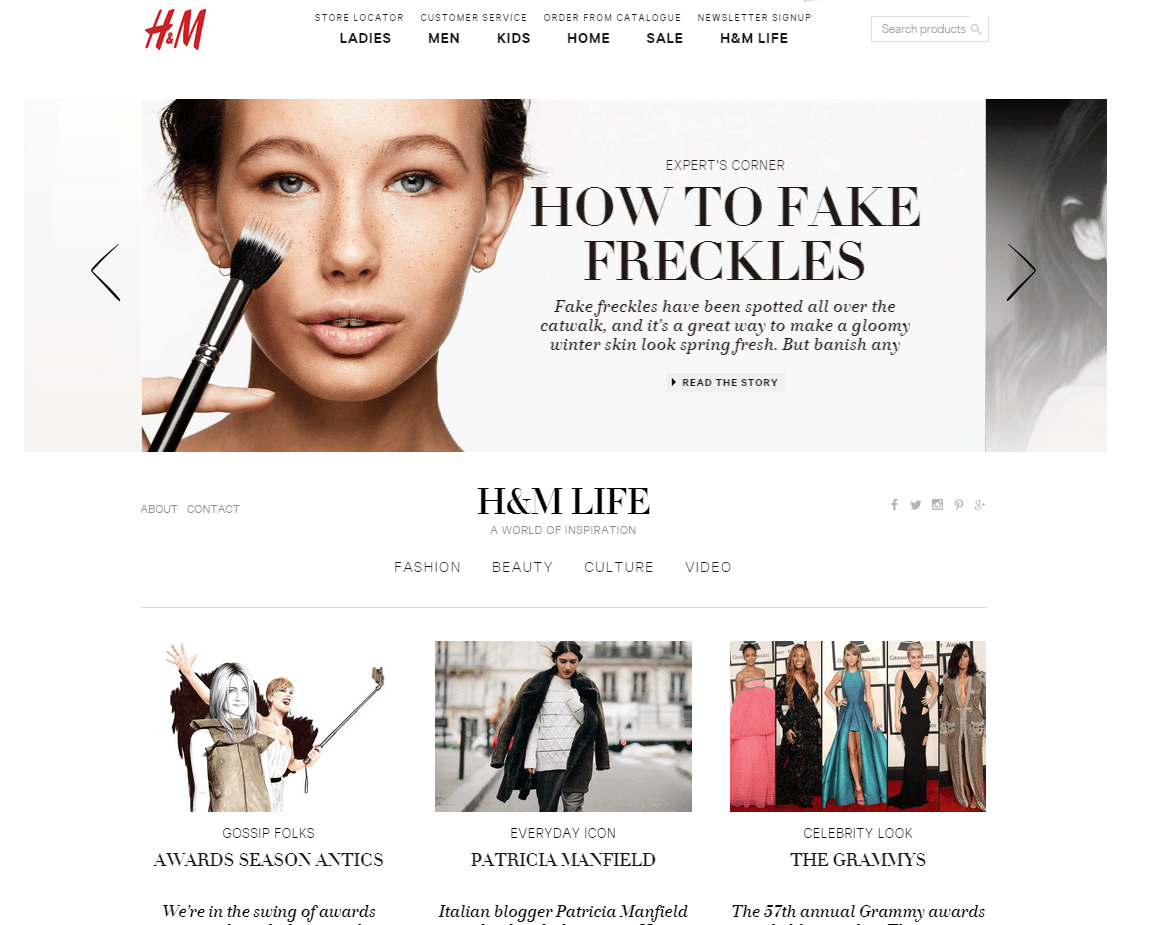
Briefing process
Once you’ve decided the topic area you’re going to cover, and the focus of each individual page within the hub, how do you go about actually getting the content created?
Behind every good content hub, there is a strong brief. At Fresh Egg, we have a solid briefing process that helps us make sure that a) the campaign lead is confident that the correct work is being done, and b) the content creator is confident they’re creating exactly what’s needed.
We brief both the hub concept and individual pages. Here’s a snapshot of the information contained within a Fresh Egg content hub brief.
Briefing the hub concept
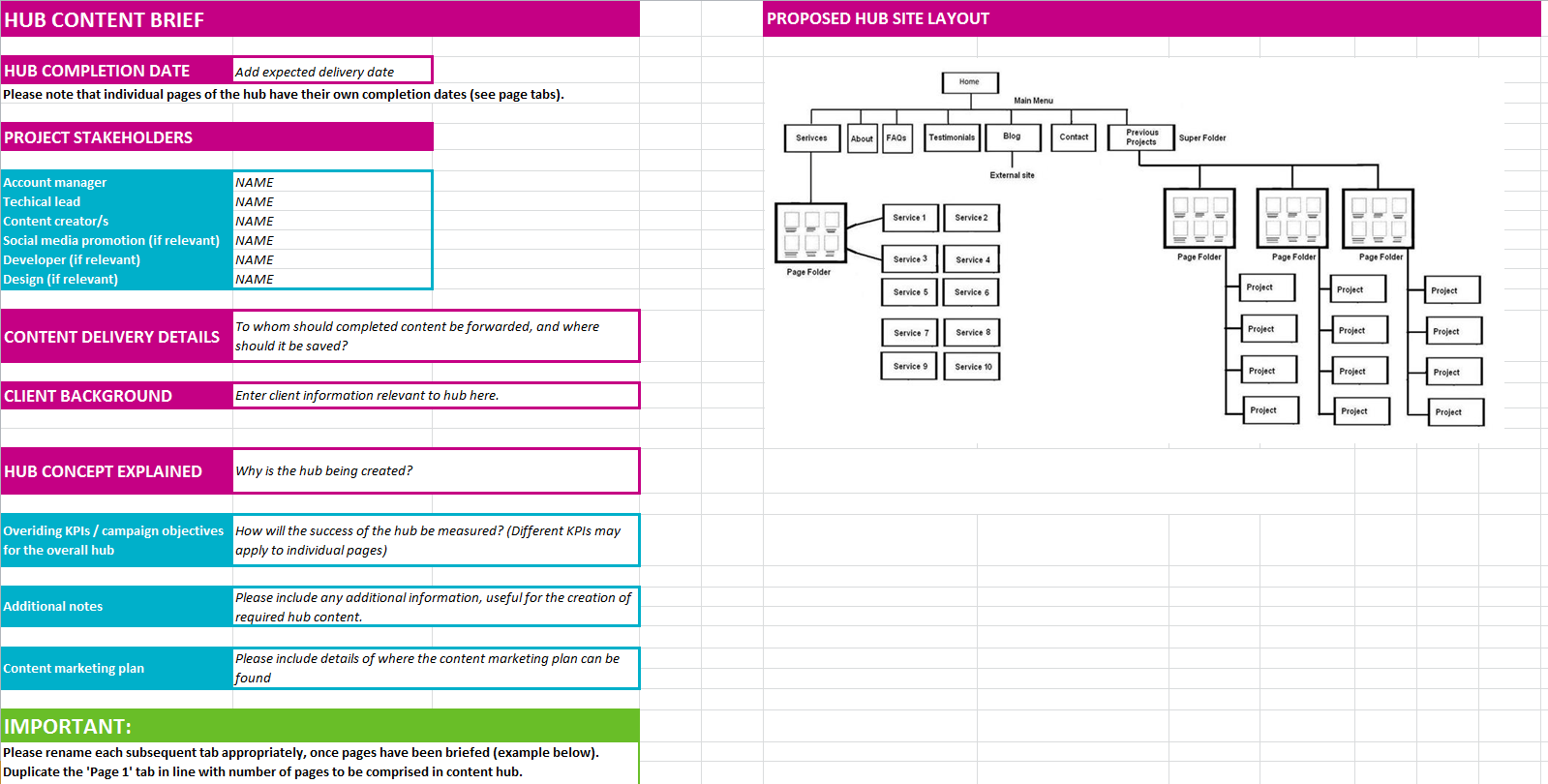
The brief contains:
- Delivery date
- Project stakeholders from across the business
- Content delivery details
- Client information
- Explanation of why the content hub is being created
- Objectives and KPIs against which the performance of the hub will be measured
- Initial promotion and content marketing plans for the hub
- Proposed hub layout and structure
Briefing individual hub pages
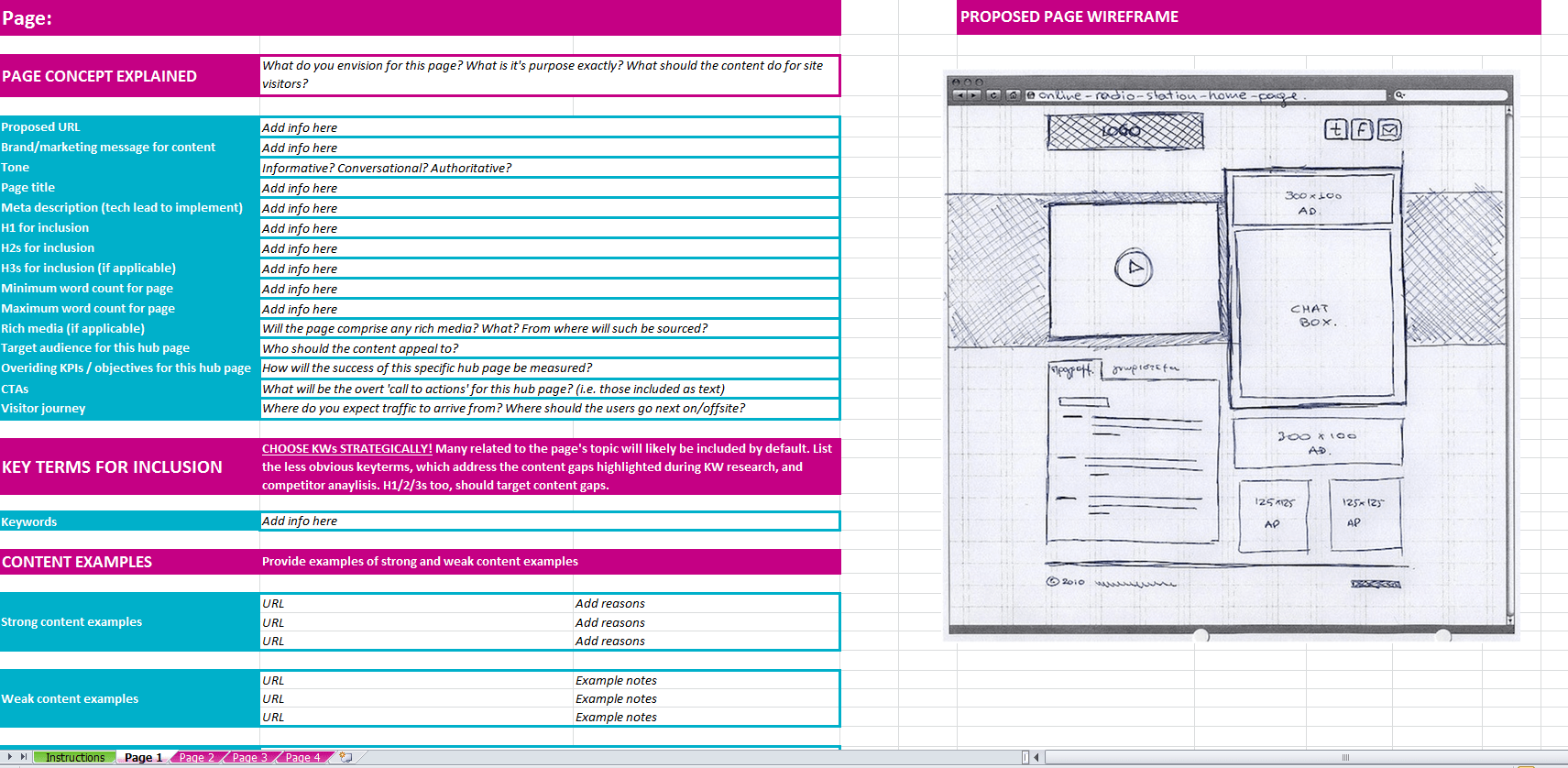
The brief contains:
- Explanation of page concept
- Proposed URL
- Brand/marketing message for content
- Tone of voice
- Technical info, including page title, meta description, headings etc.
- Required word count (although this is often just a guide – a good bit of content is as long as it needs to be)
- Any rich media – such as video or embedded social feeds – that must be included on the page
- Target audience for the hub page
- KPIs and objectives for the hub page
- Internal links to be included – ensuring it’s as easy as possible for the user to find related content
- External links to be included – any useful impartial resources that will be helpful to the user
- Calls to action to be included within the page
- Visitor journey – where visitors are expected to arrive from, and where you expect them to go after they’ve finished with the page
- Proposed page wireframe – even if it’s just a rough ‘back of a fag packet’ drawing – to give the content creator an understanding of what the page is supposed to look like
The briefs are completed by the project lead – often with input from the content creator themselves– to make sure everyone is happy with what is required (including the client).
Step 2: build and integration

Creating the content is only half the battle – how you publish that content onsite is equally important. You need to ensure the publication of your new content is technically sound, making it as easy as possible for both users and search engines to understand the relationships between the different pieces of content, and to and from other areas of your website.
The importance of a flexible CMS
Creating and publishing content using an effective content management system (CMS) means:
- You can regularly update content so it is consistently fresh and reflects changing trends
- The process of adding additional content is quick, easy and can be done by any team member
- It’s easy to add any rich media you need, such as images, video and widgets
- SEO elements – such as meta descriptions and page titles, plus Open Graph tags for social media content – can be managed at a page level, offering a greater level of control
Integration and URL structure
Your new content hub will (hopefully) house content you’re proud of – content that your customers will love. To show both users and search engines that this content is worth engaging with, it needs to be as findable as possible onsite, and fully integrated with your existing site.
In terms of URL structure, what this should look like will depend on your existing site taxonomy, and the nature/topic of the content you’ve created.
Typically, you will have the ‘hub homepage’ as a subfolder, and then the hub pages will sit within that subfolder. So, for example:
- Hub homepage = www.yoursite.co.uk/hub-homepage
- Hub page 1 = www.yoursite.co.uk/hub-homepage/page-1
- Hub page 2 = www.yoursite.co.uk/hub-homepage/page-2
- And so on…
Consistency is key – this will group the related pages together in a search engine’s (and a user’s) eyes.
Not only must the hub be technically consistent with itself, but also with your existing site. The hub should sit within your site’s existing taxonomy rather than out on its own somewhere. Users and search engines must be able to access the content within the site structure from where they would expect to find it. This applies to internal linking too – make it as easy as possible for users to navigate to the content from relevant places.
Click-depth – the number of clicks it takes to get to the hub from your site’s homepage – is also a consideration. Broadly, the fewer clicks it takes to get to the content from the homepage, the better. You don’t want your content to be hidden away – you want people to find it quickly, and read it. That said, it’s important to balance this with the rest of the site; don’t let pre-existing important pages suffer at the hands of your new hub.
Reverse proxy
Sometimes it’s not as easy as you’d like to add new content pages to a website. If your CMS isn’t flexible enough to easily add new content, or you haven’t got enough developmental resource available to devote to the building of new content, it can be a bit of a nightmare.
That’s where reverse proxies come in.
A reverse proxy acts as a gateway server, enabling one web server to serve content from another web server transparently. It can be configured to serve cached content, offering performance improvements and reducing the round trips between the gateway and the content server.
What does that actually mean? It means that agencies like us can not only own the creation of the content itself, but also the design, build and hosting of the content using our own CMS and servers. It provides an SEO-friendly way to mirror content from one domain to another, and have it indexed by Google.
The work your site’s development team would need to do is minimal: implementing a reverse proxy to load the content hub into your website, under an agreed folder structure.
Looking for a reliable CMS for your new content hub – or even your entire site? Get in touch to find out about Fresh Egg’s offering.
Step 3: promotion
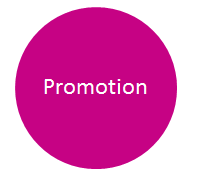
Once the content hub is live, it’s time to get it in front of as many relevant eyes (aka. potential customers) as possible. If you’ve come up with a solid content hub topic with a series of focused and well-thought out pages, ideas for the different groups of people to promote that content to should be self-evident.
Remember: It’s important to think about how you’re going to promote your content hub when you’re generating the content in the first place. Ask yourself who you’re trying to attract with the content you’re creating and think about where they can be found on the web. Don’t think rankings; think visibility.
How best to promote the information within your hub will depend on your brand, your content and your industry. Here are some ideas to get you started:
- Outreach to relevant websites/communities – Outreach isn’t about building meaningless links anymore. It’s about building relationships with other sites and brands that naturally share an audience with you. Where on the web can you find the people who will be interested in your content? You should strive to get relevant referral traffic that will convert
- Generate partnerships and endorsements – Are there any industry bodies that would be happy to endorse the content you’ve created and might even be happy to develop a partnership? For example, for Nationwide Vehicle Contracts’ maintenance and road law hubs, Fresh Egg developed a partnership with the Institute of Advanced Motorists (IAM). Hub pages – for example, the tyre maintenance page – display the IAM kite mark, reinforcing the trustworthiness of the content to users. IAM also published a press release announcing the partnership, helping to push the Nationwide Vehicle Contracts brand in front of a conscientious motoring audience
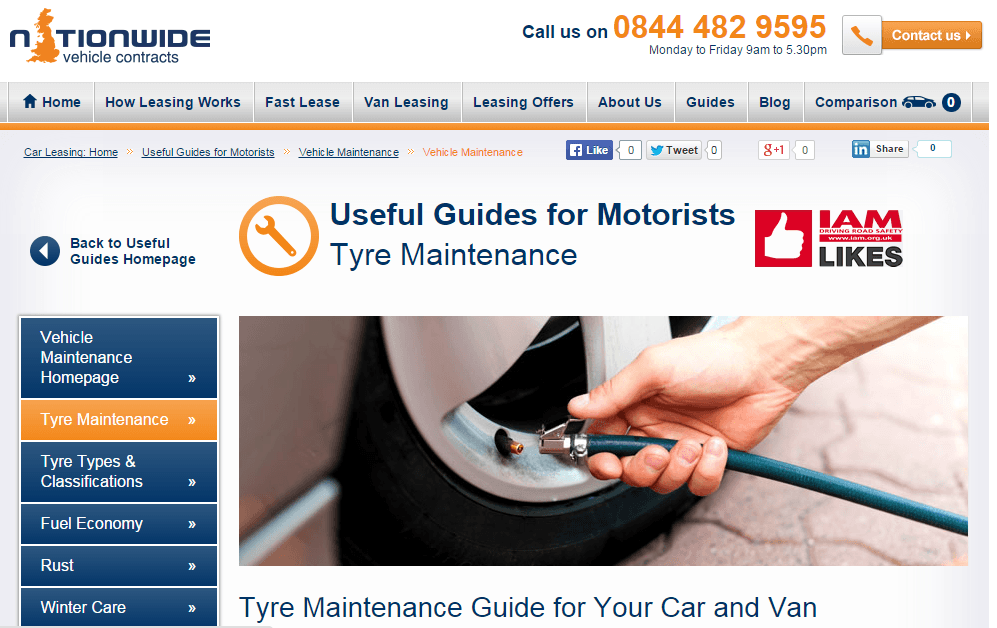
- Outreach to people or organisations featured in your content – If you’ve included content about a particular group, company, organisation etc. in your hub, it provides the perfect opportunity for outreach. Naturally, if you can show that you’ve helped promote their work, they’ll be more inclined to help you promote yours (provided the content is worth promoting, of course)
Fresh Egg took this approach when promoting the food and drink section of the Discover Cornwall hub for Sykes Cottages. Various restaurants and cafes were featured in the food and drink videos created for the hub, and many of them were happy to help promote the videos once they were published
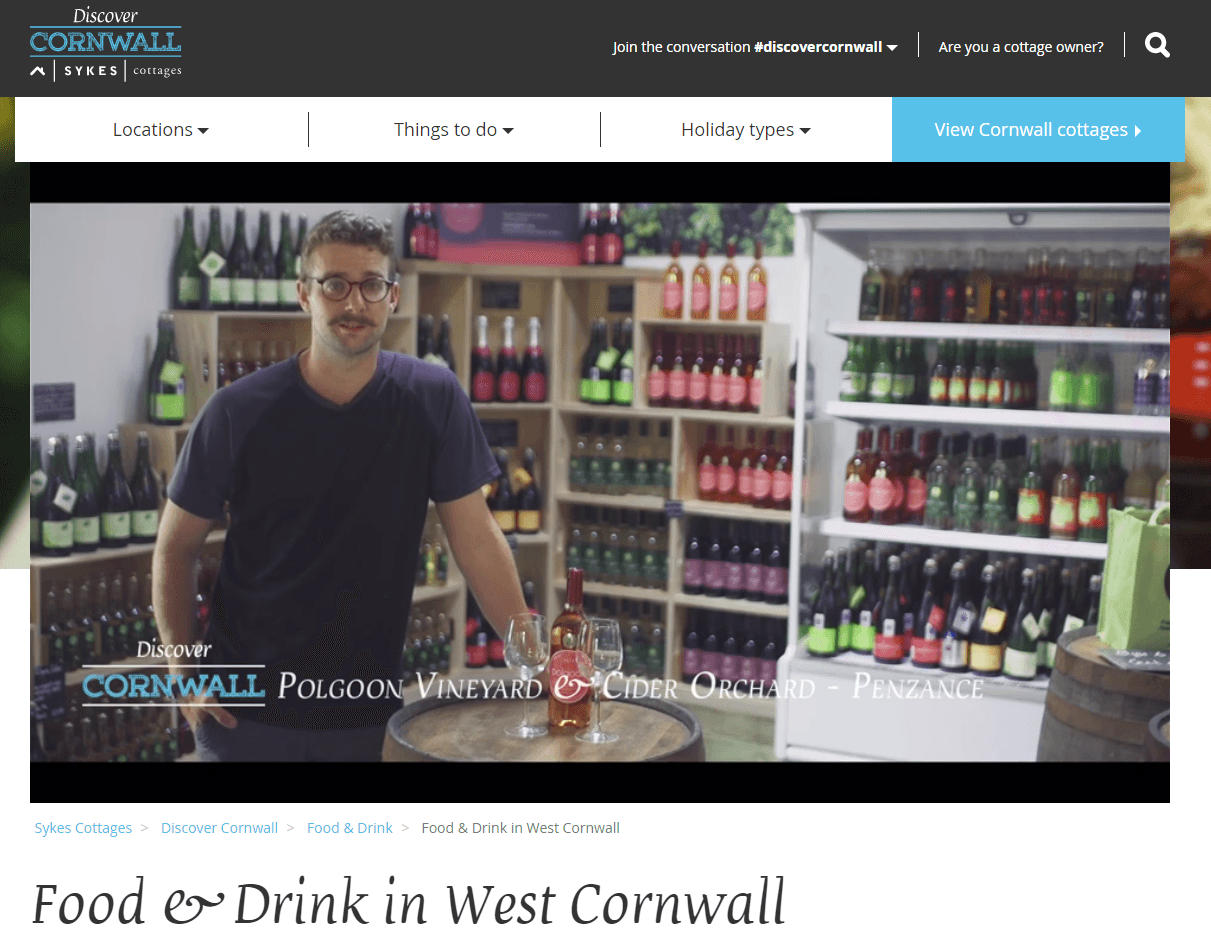
- Outreach to existing partners – If you’ve got partnerships or relationships with other websites or businesses already, think about how they can be leveraged to help you promote your new content
- Promotion to existing customers – Depending on the nature of the content you’ve created, the hub may well be just as useful for existing customers as it is for attracting new ones. If you’ve got a marketing email list or regular newsletter, make sure you shout about your new guides – you should be proud of your hard work, after all. Your new content should be used as an opportunity to build and maintain those lists as well – you are building advocacy and loyalty among new and existing customers
- Social media promotion – If you’ve got an engaged social following, make the most of it. Promote your content to your existing fans and followers in such a way that will engage with them – and encourage them to share your content for you
- Paid advertising – Use biddable media – pay per click (PPC), display and social advertising – to promote your content to a relevant audience outside of your existing customers
- Press releases – If your hub covers a particularly newsworthy topic, a press release can help you gain extra coverage. The key here is the newsworthiness of what you’ve created – which news outlets would care about your content, and why should they? If you can answer both of those questions honestly and convincingly, a press release could be just what you need
- Repurposing content – Can you use the information you have and present it in a different way? Maybe a different format will be better suited to a particular channel. For example, if you’ve created a written ‘how-to’ guide, can you repurpose it as a Slideshare presentation? A video? A podcast? A webinar? Can you create a series of blog posts promoting your new content? Different content formats open doors to a whole host of other promotional channels – video on YouTube, shorter videos on Vine, images on Instagram and Pinterest, ebooks on Amazon – the list goes on
- Onsite promotion/linking – Make sure that your new content hub can be found in the places your users would expect it to be on your own website. The whole point of a content hub is to make it as easy as possible for users to navigate between related pages – and this extends to existing pages too. Shows users and search engines that the content you’ve created is important and interesting by providing prominent internal links to it from relevant places on your site
Step 4: reporting and refinement

As with all things in digital marketing, there’s no such thing as a finished project. Your content hub should be a living creature that is updated and improved upon, according to how well it’s performing.
What to report on to measure the success of your content hub
To know what needs refining within your hub, you first need to know what’s performing well and what isn’t.
Ultimately, you need to measure the success of your hub against the original objectives you set at the start of the project. The important thing is to choose metrics that support your aims, rather than just tell you what you want to hear. Useful metrics include:
- Levels of traffic to the content, including organic and referral traffic
- Conversions attributed to the new content (using event tracking in GA, for example)
- Number and quality of third party websites mentioning or promoting the content
- Levels of social shares and engagement
- Returning visitors
- Visitor journey – where are people coming from and where are they navigating to after the hub pages?
- Customer feedback – are people happy with the information that is being provided? What else is missing?
It’s worth re-iterating that content hubs are a long-term strategy, so it’s vitally important not to judge the success or failure of your work too soon. Think about the lifetime value of the content – the page may not generate millions of sales as soon as it goes live, but the impact of steadily increasing traffic over time should not be underestimated.
After some number-crunching it should become clear which areas need more attention.
You’re then back at the beginning of the process – time to plan and scope out the revisions, get it created, built and published, promote it, and analyse its performance.
What Fresh Egg can do for you
If you’re considering adding a content hub to your website, we can:
- Fully design and build the hub
- Build a CMS to integrate with the hub and work with your internal teams to implement
- Advise and support on technical SEO elements of the project integration
- Create a content strategy for the hub
- Produce all content in the hub
- Create additional rich content, such as video content and tools
- Create a full inbound marketing strategy to help drive traffic and visibility
Contact us today to find out how we can work with you to create the content your audience is looking for.
Want to know more about the content services we offer before you get in touch? Take a look at our content marketing pages.